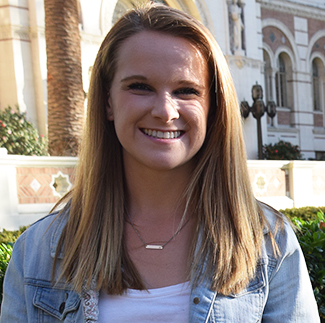
Dana Austin
USC sophomore Dana Austin was interested in Professor Jessica Marglin’s course on the Jews of Spain because of its connection to her Spanish major. But the course actually led to her exploration of a different language altogether, with the help of the Visual History Archive: Ladino.
Like many other students in the class, Austin took Religion 359, Culture in Diaspora: The Jews of Spain, taught by Professor Marglin, because it fulfilled her GE (general education) requirement. But Professor Marglin’s engaging lectures and the unique subject matter turned the course into Austin’s favorite GE that she’s taken at USC.
She was already familiar with Spanish history, because of her double major in Spanish and accounting, but Austin said the Jewish culture and religion covered in the class was completely new to her.
To help students with their final papers, Marglin introduced them to the Visual History Archive as a possible primary source. Austin was impressed by the number of testimonies in the archive and how easy they are to search, so she incorporated testimony into her paper.
Austin’s paper focuses on the decline of the Ladino language, which was spoken by Sephardic Jews in Spain before World War II. She argues that even before the persecution of Jews during the war, fewer and fewer people were speaking and learning Ladino.
Testimonies of Ladino speakers in the Visual History Archive indicated that even in the 1940s, Ladino was mostly spoken by the older generations.
“The Holocaust was a final blow in its decline, but it had been declining for centuries before,” Austin said.
Marglin was so impressed by Austin’s paper that she invited her, along with another classmate, Lara Sassounian, and graduate student/teaching assistant Andrew Soria, to present her research at the 5th annual ucLADINO symposium at UCLA March 2-3, 2016. Austin and Sassounian will be the only undergraduates to present.
Austin said testimony helped her understand the personal experiences of actual Ladino speakers.
“To hear their voices and their accents – you don’t think of that when you’re reading [a textbook],” Austin said. “I think it’s the most raw form of primary source that there is.”